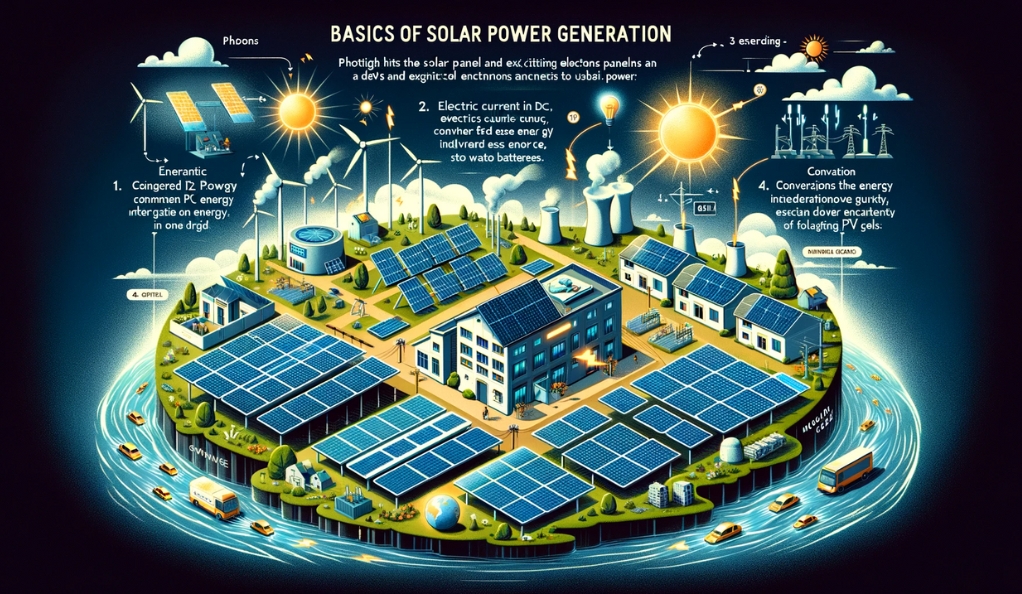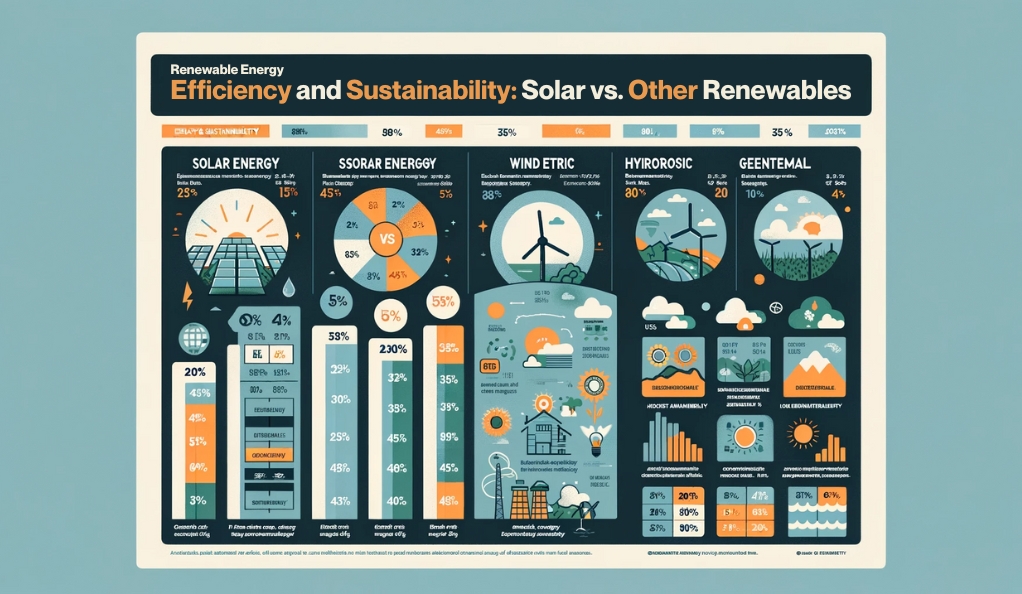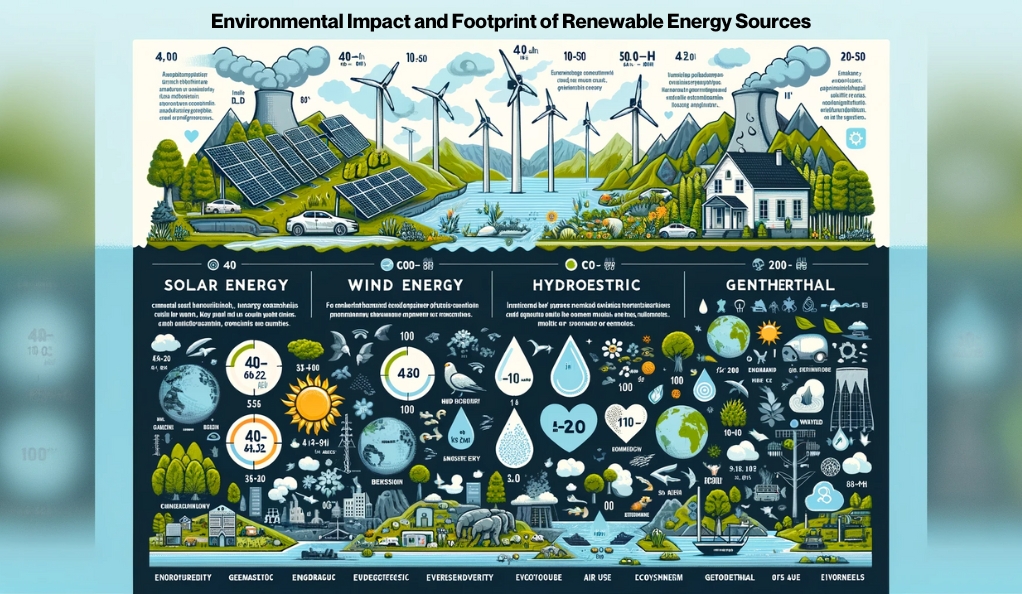In the quest for a sustainable future, renewable energy stands at the forefront of technological and environmental advancements. As the world grapples with the challenges of climate change and the depletion of traditional fossil fuels, the shift towards renewable energy sources has become imperative. This article embarks on an exploratory journey, comparing solar energy with other renewable sources, to understand their roles in shaping our energy future.
The Rise of Renewable Energy
Renewable energy, derived from natural processes that are continuously replenished, includes sources like sunlight, wind, rain, tides, waves, and geothermal heat. Unlike fossil fuels, these sources offer a sustainable alternative, minimizing environmental impact and promising an inexhaustible supply of energy. The global energy landscape is witnessing a paradigm shift, with renewables increasingly contributing to national grids, powering homes, and fueling industries.
Why Sustainable Energy Solutions Matter
The transition to renewable energy is not just a technological shift but a necessary step towards environmental stewardship. Sustainable energy solutions offer multiple benefits:
- Reduced Carbon Footprint: Renewable energy sources emit little to no greenhouse gases during operation, significantly reducing the carbon footprint.
- Energy Security: Diversifying energy supply with renewables reduces dependence on imported fuels, enhancing energy security.
- Economic Growth: The renewable energy sector is a burgeoning field, offering job opportunities and economic growth.
- Health and Environmental Benefits: By reducing air pollution, renewable energy sources contribute to better health outcomes and a cleaner environment.
The Rising Importance of Sustainable Energy Solutions
As the world’s population grows and industrializes, the demand for energy escalates. Renewable energy is not just an alternative; it’s a necessity for a sustainable future. Countries around the globe are setting ambitious targets to increase their share of renewables in energy production. This shift is driven by the urgent need to address climate change, reduce air pollution, and create a more sustainable, resilient energy system.
Understanding Solar Energy
Solar energy, harnessed from the sun’s rays, is a cornerstone in the renewable energy landscape. Its potential is vast and its implications for a sustainable energy future are significant. We explore the fundamental principles of solar power generation and examine the most recent advancements in solar technology.
Basics of Solar Power Generation

Solar power is generated using photovoltaic (PV) cells, which convert sunlight directly into electricity. This process, known as the photovoltaic effect, involves the absorption of photons (light particles) and the release of electrons, creating an electric current. Solar panels, composed of multiple PV cells, are installed in arrays to capture sunlight efficiently. Here’s a simplified breakdown of the process:
- Sunlight Hits the Solar Panel: Photons in sunlight strike the solar panel, exciting electrons in the PV cells.
- Electric Current is Generated: The movement of these electrons creates an electric current.
- Conversion to Usable Power: An inverter converts the direct current (DC) into alternating current (AC), which can be used in homes and businesses.
- Integration into the Grid: Excess energy can be fed into the power grid or stored in batteries for later use.
Advancements in Solar Technology
The field of solar energy is rapidly evolving, with technological advancements enhancing efficiency and reducing costs. Some notable developments include:
- High-Efficiency Solar Panels: New materials and designs, such as bifacial solar panels and PERC (Passivated Emitter and Rear Cell) technology, are increasing the efficiency of solar panels.
- Solar Energy Storage: Advancements in battery technology, like lithium-ion and flow batteries, are improving the storage of solar energy, making it a more reliable power source.
- Building-Integrated Photovoltaics (BIPV): These are solar cells integrated into building materials, like roof tiles or windows, making solar power generation more aesthetically pleasing and space-efficient.
- Floating Solar Farms: Solar panels installed on bodies of water, known as floatovoltaics, are gaining popularity, especially in areas with limited land availability.
The Potential and Challenges
Solar energy’s potential is immense, given the abundant and widespread availability of sunlight. However, there are challenges:
- Intermittency: Solar power is dependent on sunlight, making it less reliable at night or during cloudy weather.
- Land Use: Large-scale solar farms require significant land, which can lead to land use conflicts.
- Energy Density: Solar energy has a lower energy density compared to fossil fuels, meaning more space is needed to produce the same amount of energy.
Despite these challenges, the advancements in solar technology and the decreasing cost of solar installations are making solar energy an increasingly viable and attractive option in the renewable energy spectrum.
Other Key Renewable Energy Sources
While solar energy is a major player in the renewable sector, it’s part of a diverse array of sustainable energy sources. Each of these sources has its own unique benefits and challenges. We examine wind power, hydroelectric energy, biomass energy, and geothermal energy, providing a comprehensive overview of the renewable energy spectrum.
Wind Power
- How It Works: Wind turbines convert the kinetic energy of wind into mechanical power, which is then converted into electricity.
- Advantages:
- High Efficiency: Wind turbines can convert over 45% of the wind’s kinetic energy into electricity.
- Low Operational Costs: Once installed, wind turbines have low maintenance and operational costs.
- Challenges:
- Intermittency: Like solar, wind power is weather-dependent and can be unpredictable.
- Land Use: Large wind farms require significant space, though the land can often still be used for agriculture.
Hydroelectric Energy
- How It Works: Hydroelectric power plants use the flow of water from rivers, dams, or waterfalls to spin turbines, generating electricity.
- Advantages:
- Reliable and Consistent: Water flow is generally more predictable and consistent than wind or solar.
- Storage Capabilities: Some hydroelectric plants can store energy in the form of water in reservoirs.
- Challenges:
- Environmental Impact: Dams can have significant ecological impacts, affecting water flow and aquatic life.
- Location-Specific: Hydroelectric plants are dependent on suitable geographical locations.
Biomass Energy
- How It Works: Biomass energy is produced from organic materials (wood, agricultural residues, or animal waste) either by burning to produce heat or using biochemical processes to create biofuels.
- Advantages:
- Versatility: Biomass can be used for heating, electricity generation, and as a transport fuel.
- Waste Reduction: Utilizes waste materials, reducing landfill use and methane emissions.
- Challenges:
- Carbon Emissions: Burning biomass releases carbon dioxide, though it’s partly offset by the carbon absorbed during the plant’s growth.
- Land Use: Large-scale biomass production can compete with food production for land.
Geothermal Energy
- How It Works: Geothermal energy harnesses heat from the Earth’s interior to generate electricity or provide direct heating.
- Advantages:
- Consistency: Unlike solar and wind, geothermal provides a constant energy source.
- Small Footprint: Geothermal plants typically require less land area than other renewable facilities.
- Challenges:
- Location Limitations: Effective only in regions with significant geothermal activity.
- Upfront Costs: High initial investment for plant construction and drilling.
Efficiency and Sustainability: Solar vs. Other Renewables

In the quest for a sustainable future, understanding the efficiency and sustainability of different renewable energy sources is crucial. This part compares solar energy with other renewables in terms of energy efficiency and long-term sustainability.
Energy Efficiency Comparison
Energy efficiency in renewable sources is measured by how effectively they convert natural energy into electricity. Here’s a comparative overview:
| Renewable Source | Efficiency Rate | Notes |
|---|---|---|
| Solar Energy | 15-22% | Efficiency depends on panel technology and sunlight availability. |
| Wind Energy | 35-45% | Offshore wind farms tend to have higher efficiency. |
| Hydroelectric | 80-90% | Highly efficient but dependent on water availability. |
| Biomass | 20-25% | Efficiency varies based on the type of biomass and conversion technology. |
| Geothermal | 10-20% | Efficiency can be higher in regions with intense geothermal activity. |
Long-term Sustainability Analysis
Sustainability of renewable energy sources encompasses not just the production of energy but also the environmental impact, resource availability, and lifespan of the technology.
- Solar Energy:
- Resource Availability: Virtually limitless, with sunlight available globally.
- Environmental Impact: Low impact, though manufacturing and disposal of panels can have environmental costs.
- Lifespan: Solar panels typically last 25-30 years.
- Wind Energy:
- Resource Availability: Abundant in many regions, especially coastal areas.
- Environmental Impact: Minimal emissions, but wind turbines can impact local wildlife, like birds.
- Lifespan: Wind turbines have a lifespan of about 20-25 years.
- Hydroelectric Energy:
- Resource Availability: Dependent on water sources, which can be affected by climate change.
- Environmental Impact: Can significantly alter local ecosystems and water flow.
- Lifespan: Hydroelectric plants can operate for several decades, even up to a century.
- Biomass Energy:
- Resource Availability: Dependent on organic material availability, which can compete with food production.
- Environmental Impact: Can produce emissions, but sustainable practices can mitigate impacts.
- Lifespan: Biomass plants have varied lifespans depending on technology and fuel source.
- Geothermal Energy:
- Resource Availability: Limited to geologically active regions.
- Environmental Impact: Low emissions, but can lead to land subsidence and water contamination if not managed properly.
- Lifespan: Geothermal plants can operate for 30-50 years.
Economic Aspects: Cost Analysis and Investment in Renewable Energy
The transition to renewable energy is not just an environmental or technological issue but also an economic one. This segment the economic aspects of solar energy compared to other renewable sources, focusing on costs, financial benefits, and government incentives.
Initial Setup Costs
The initial setup cost is a crucial factor in the adoption of renewable energy. Here’s a comparative analysis:
- Renewable Source: Solar Energy
- Average Initial Cost (USD per kW): 1,000 – 3,500
- Notes: Costs have decreased significantly over the past decade.
- Renewable Source: Wind Energy
- Average Initial Cost (USD per kW): 1,200 – 3,700
- Notes: Offshore wind farms are generally more expensive.
- Renewable Source: Hydroelectric
- Average Initial Cost (USD per kW): 1,000 – 5,000
- Notes: Large-scale projects like dams are on the higher end.
- Renewable Source: Biomass
- Average Initial Cost (USD per kW): 2,000 – 5,000
- Notes: Costs vary based on the technology and scale.
- Renewable Source: Geothermal
- Average Initial Cost (USD per kW): 2,500 – 5,000
- Notes: High initial costs due to drilling and exploration.
Long-term Financial Benefits
The long-term financial benefits of renewable energy sources are measured by their return on investment (ROI), operational costs, and lifespan.
- Solar Energy:
- ROI: High, due to decreasing costs and increasing efficiency.
- Operational Costs: Relatively low; mainly maintenance and occasional cleaning.
- Lifespan: 25-30 years, offering extended periods of energy production.
- Wind Energy:
- ROI: Good, especially for large-scale wind farms.
- Operational Costs: Moderate; includes maintenance and part replacements.
- Lifespan: 20-25 years, with consistent energy production.
- Hydroelectric Energy:
- ROI: Very high, especially for large dams.
- Operational Costs: Low; hydro plants are generally robust and long-lasting.
- Lifespan: Can exceed 50 years, providing long-term energy generation.
- Biomass Energy:
- ROI: Moderate; depends on fuel availability and technology.
- Operational Costs: Higher due to fuel costs and maintenance.
- Lifespan: Varies; dependent on technology and maintenance.
- Geothermal Energy:
- ROI: High in geologically suitable areas.
- Operational Costs: Low; the energy source is constant and reliable.
- Lifespan: 30-50 years, ensuring long-term energy production.
Government Incentives and Subsidies
Government incentives play a significant role in promoting renewable energy. These can include tax credits, rebates, feed-in tariffs, and grants. For instance, solar energy has benefited greatly from various government incentives globally, such as the Investment Tax Credit (ITC) in the United States, which has significantly reduced the cost of solar installations. Similar incentives are available for other renewable sources, varying by country and region.
Environmental Impact and Footprint of Renewable Energy Sources

The shift towards renewable energy is largely driven by the need to reduce environmental impacts, particularly carbon emissions. However, each renewable energy source has its own environmental footprint. This segment examines these impacts in detail.
Carbon Footprint Comparison
One of the primary environmental considerations is the carbon footprint, which refers to the total greenhouse gas emissions caused directly and indirectly by an energy source. Here’s a comparative overview:
| Renewable Source | Estimated Emissions (gCO2eq/kWh) | Notes |
|---|---|---|
| Solar Energy | 40 – 50 | Emissions mainly from manufacturing and transportation of panels. |
| Wind Energy | 10 – 20 | Among the lowest in renewable sources, mostly from manufacturing turbines. |
| Hydroelectric | 1 – 20 | Emissions vary depending on the size and type of hydroelectric project. |
| Biomass | 100 – 200 | Emissions depend on the type of biomass and combustion efficiency. |
| Geothermal | 50 – 100 | Emissions mostly from drilling and extraction processes. |
Impact on Ecosystems and Biodiversity
Besides carbon emissions, renewable energy sources can have other environmental impacts, particularly on ecosystems and biodiversity.
- Solar Energy:
- Land Use: Large solar farms can consume significant land area, potentially impacting local ecosystems.
- Wildlife: Minimal direct impact on wildlife, though land use changes can have indirect effects.
- Wind Energy:
- Birds and Bats: Wind turbines can pose a threat to flying wildlife, though mitigation strategies are improving.
- Land Use: Wind farms require large areas, but the land can often still be used for agriculture.
- Hydroelectric Energy:
- Aquatic Ecosystems: Dams can significantly alter river ecosystems, affecting fish migration and river flow.
- Land Flooding: Large reservoirs can flood extensive areas, impacting local flora and fauna.
- Biomass Energy:
- Land Use: Can compete with food production and lead to deforestation if not managed sustainably.
- Air Quality: Burning biomass releases pollutants, though modern technologies are reducing emissions.
- Geothermal Energy:
- Land Use: Generally has a small footprint, but can alter local geothermal and groundwater systems.
- Water Use: Uses large quantities of water, which can be a concern in arid regions.
Conclusion: The Role of Solar in the Renewable Energy Landscape
Solar energy, with its unique characteristics and rapid technological advancements, has emerged as a key player in the renewable energy landscape. Its ability to harness the abundant and widespread availability of sunlight positions it as a crucial component in the global shift towards sustainable energy. While challenges such as intermittency and land use remain, the continuous improvements in solar panel efficiency, coupled with decreasing costs and supportive government policies, are making solar energy increasingly viable and attractive. Solar energy’s scalability, from small rooftop installations to large solar farms, allows it to be adapted to a wide range of environments and applications, making it a versatile and accessible energy source.
As the world moves towards a more sustainable and environmentally friendly future, the role of solar energy cannot be overstated. It stands not in isolation but as a complementary force alongside other renewable sources like wind, hydroelectric, biomass, and geothermal energy. Each of these sources has its strengths and challenges, but together, they form a diverse and robust portfolio of renewable energy options. Solar energy, with its significant potential for innovation and growth, is poised to play a pivotal role in this renewable energy mix, contributing to energy security, economic development, and environmental sustainability. The future of energy is not dependent on a single source but on a harmonious integration of all renewable technologies, with solar energy shining brightly at the forefront.
